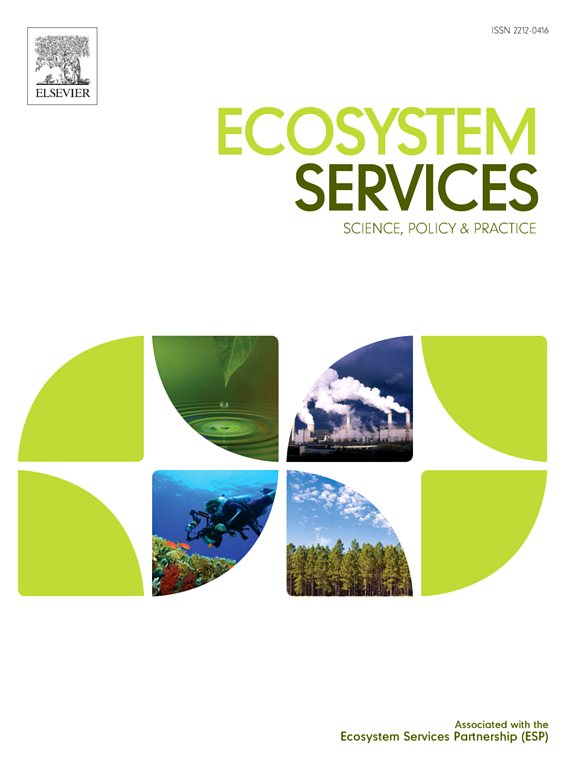Integrating multiple landscape management strategies to optimise conservation under climate and planning scenarios: a case study in the Iberian Peninsula
IF 6.6
2区 环境科学与生态学
Q1 ECOLOGY
引用次数: 0
Abstract
Global change demands dynamic landscape management that integrates different strategies (e.g. promoting rewilding or traditional farming practices) to address the impact of climate and land use change. Planning for management strategies individually can lead to severe trade-offs between objectives, high opportunity costs and challenging implementation. Integrated management plans are needed to optimise the combination of multiple management strategies. We used the multi-action planning tool ‘Prioriactions’ to prioritise the spatial allocation of four management strategies (Afforestation, Rewilding, Farmland Return and Agroforestry Return) in the Meseta Ibérica transboundary Biosphere Reserve. We aimed to achieve targets for conservation of species suitable area and ecosystem services supply while minimising fire hazard under different climate scenarios. We tested this approach under contrasting planning scenarios depicting different management priorities (Equally Weighted, Forest Maximising and Open Maximising). By integrating multiple management strategies, we could achieve management goals for biodiversity and ecosystem services under different planning scenarios, minimising trade-offs and deriving recommendations easier to uptake. The spatial allocation and extent of management strategies varied according to climate change and planning scenarios. Afforestation was needed when putting more priority on forest species and carbon sequestration, while more Farmland Return was allocated when preserving open habitat species and agriculture. Fire hazard was higher in Rewilding areas and lower in Farmland Return and Agroforestry Return areas. The novelty of our approach lies in its capacity to combine different management strategies and provide an optimised spatial arrangement based on management features, making it suitable for planning in dynamic and complex environments where multiple pressures and objectives must be considered.
整合多种景观管理策略以优化气候和规划情景下的保护:伊比利亚半岛的案例研究
全球变化需要动态的景观管理,整合不同的战略(例如,促进重新放野或传统耕作方式),以应对气候和土地利用变化的影响。单独规划管理策略可能导致在目标、高机会成本和具有挑战性的执行之间进行严重的权衡。需要综合管理计划来优化多种管理策略的组合。我们使用多行动规划工具“优先行动”对Meseta ibacria跨界生物圈保护区的四种管理策略(造林、野化、农田归还和农林业归还)的空间分配进行了优先排序。我们的目标是在不同的气候情况下,达到保护物种和生态系统的目标,同时尽量减少火灾的危险。我们在描述不同管理优先级(均等加权、森林最大化和开放最大化)的对比规划方案下测试了这种方法。通过整合多种管理策略,我们可以在不同的规划情景下实现生物多样性和生态系统服务的管理目标,最大限度地减少权衡,并得出更容易接受的建议。管理策略的空间分配和程度因气候变化和规划情景而异。在保护森林物种和碳汇方面,应加强造林;在保护开放生境物种和保护农业方面,应加大退耕力度。还原区火灾危险性较高,退耕还林和农林业还原区火灾危险性较低。我们的方法的新颖之处在于它能够结合不同的管理策略,并根据管理特征提供优化的空间安排,使其适用于必须考虑多种压力和目标的动态和复杂环境的规划。
本文章由计算机程序翻译,如有差异,请以英文原文为准。
求助全文
约1分钟内获得全文
求助全文
来源期刊

Ecosystem Services
ECOLOGYENVIRONMENTAL SCIENCES&-ENVIRONMENTAL SCIENCES
CiteScore
14.90
自引率
7.90%
发文量
109
期刊介绍:
Ecosystem Services is an international, interdisciplinary journal that is associated with the Ecosystem Services Partnership (ESP). The journal is dedicated to exploring the science, policy, and practice related to ecosystem services, which are the various ways in which ecosystems contribute to human well-being, both directly and indirectly.
Ecosystem Services contributes to the broader goal of ensuring that the benefits of ecosystems are recognized, valued, and sustainably managed for the well-being of current and future generations. The journal serves as a platform for scholars, practitioners, policymakers, and other stakeholders to share their findings and insights, fostering collaboration and innovation in the field of ecosystem services.
 求助内容:
求助内容: 应助结果提醒方式:
应助结果提醒方式:


